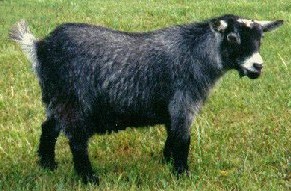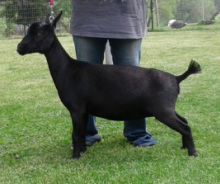Nigerian Dwarf Dairy Goat Fact Sheet
|
|
Nigerian Dwarf Goats are of West African origin, but the breed was developed in the United States.
They are believed to have first been imported to the United States as live food sources for big cats during ship transport to American zoos. The surviving goats were kept at the zoos as attractions. Shorter height is the primary breed characteristic of the Nigerian Dwarf, with does measuring no more than 22 1/2" at the withers, and bucks measuring no more than 23 1/2" at the withers (ADGA standards). Nigerian Dwarf Goats are not Pygmies, and Pygmies are not Nigerian Dwarves. They are two separate and distinct breeds. Pygmy goats are heavy-boned, and stocky with short legs and round bones. Nigerians are fine boned, and long legged with flat bones and dairy characteristics. Nigerian Dwarves are a dairy goat in miniature, most similar to the standard Swiss breeds. |
|
|
The American Goat Society (AGS) opened the herd books to Nigerian Dwarf Goats in 1983, and finished documenting foundation animals in 1992. The American Dairy Goat Association (ADGA) has accepted NDs into their registry since 2005, but did not hold the first sanctioned Nigerian Dwarf show at Nationals until 2010.
Nigerian Dwarves are the most colorful breed of goat with all colors, combination of colors, and patterns accepted. They are also the only dairy breed to occasionally have blue eyes. Nigerian Dwarf does can breed all year round, and have one to six kids at a time. Note: World record seven kids born to one doe at Sinai Thunder (2016) They are the ideal home milk goat, and give a surprising amount of high quality, sweet milk with a high butterfat content (5-10%). Their production ranges from one to eight pounds of milk per day, with an average of two and a half. Nigerian Dwarves are extremely friendly, and are great companions to small children and adults alike. Nigerian Dwarf wethers and does make excellent 4H projects! |







